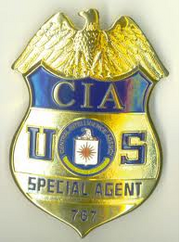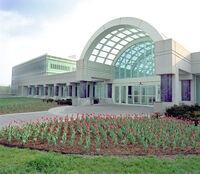|
Central Inteligence Agency
| |
|
Formed
|
1947
|
|
Home Country
|
|
|
Employees
|
Classified
|
|
Annual Budget
|
Classified
|
|
Headquarters
|
Langly, Virginia
|
|
Website
|
|
The Central Intelligence Agency (CIA) is a civilian intelligence agency of the United States government. Its primary function is collecting and analyzing information about foreign governments, corporations, and persons in order to advise public policymakers.
Prior to December 2004, the CIA was literally the central intelligence organization for the US government. The

Offical CIA special agent badge.
Intelligence Reform and Terrorism Prevention Act of 2004 created the office of the Director of National Intelligence (DNI), who took over some of the government and intelligence community (IC)-wide function that had previously been under the CIA. The DNI manages the United States Intelligence Community and in so doing it manages the intelligence cycle. Among the functions that moved to the DNI were the preparation of estimates reflecting the consolidated opinion of the 16 IC agencies, and preparation of briefings for the President.
When discussing the CIA, it is critical to understand when one is speaking of the older IC-wide responsibilities, or its present set of responsibilities. The IC still has internal politics, although an increasing number of interagency "centers", as well as the Intellipedia information sharing mechanism, are hoped to be improvements.
The current CIA still has a number of functions in common with other countries' intelligence agencies; see relationships with foreign intelligence agencies. The agency both collects and analyzes intelligence. The CIA's headquarters is in the community of Langley in the McLean CDP of Fairfax County, Virginia, a few miles west of Washington, D.C. along the Potomac River.
Sometimes, the CIA is referred to euphemistically in government and military parlance as Other Government Agencies (or OGA), particularly when its operations in a particular area are an open secret. Other terms include The Company and The Agency.
The Seal[]
The heraldic symbol that comprises the CIA seal consists of three representative parts: the "right"-facing bald eagle head atop,( "right" facing, since the eagle looks over its "right" shoulder, not the left shoulder ) the compass star (or compass rose), and the shield. The eagle is the national bird, standing for strength and alertness. The 16-point compass star represents the CIA's world-wide search for intelligence outside the United States, which is then reported to the headquarters for analysis, reporting, and re-distribution to policymakers. The compass rests upon a shield, symbolic of defense.
Other Sources of Intelligence[]
The CIA acts as the primary American HUMINT and general analytic agency, under the Director of National Intelligence, who directs or coordinates the 16 member organizations of the United States Intelligence Community. It obtains information from other U.S. government intelligence agencies, commercial information sources, and foreign intelligence services.
Other US Intelligence Agencies[]
A number of those organizations are fully or partially under the budgetary control of the United States Secretary of Defense or other cabinet officers such as the Attorney General of the United States.
As do other analytic members of the U.S. intelligence community such as the Department of State's Bureau of Intelligence and Research and the analytic division of the Defense Intelligence Agency (DIA), its raw input includes imagery intelligence IMINT collected by air and space systems of the National Reconnaissance Office (NRO) processed by the National Geospatial-Intelligence Agency (NGA), signal intelligence SIGINT of the National Security Agency (NSA), and measurement and signature intelligence MASINT from the DIA MASINT center.
Use in the Cold War[]

New CIA Headquarters
Allen Dulles, who had been a key OSS operations officer in Switzerland during the Second World War, took over from Smith, at a time where US policy was dominated by intense anticommunism. Various sources were involved, the most visible being the investigations and abuses of Senator Joseph McCarthy, and the more quiet but systematic containment doctrine developed by George Kennan, the Berlin Blockade and the Korean War. Dulles enjoyed a high degree of flexibility, as his brother, John Foster Dulles, was simultaneously Secretary of State. Concern regarding the Soviet Union and the difficulty of getting information from its closed society, which few agents could penetrate, led to solutions based on advanced technology. Among the first success was with the Lockheed U-2 aircraft, which could take pictures and collect electronic signals from an altitude above Soviet air defenses' reach. After Gary Powers was shot down by an SA-2 surface to air missile in 1960, causing an international incident, the SR-71 was developed to take over this role.
During this period, there were numerous covert actions against perceived Communist expansion. Some of the largest operations were aimed at Cuba after the overthrow of the Batista government, including assassination attempts against Fidel Castro and the dubiously deniable Bay of Pigs Invasion. There have been suggestions that the Soviet attempt to put missiles into Cuba came, indirectly, when they realized how badly they had been compromised by a US-UK defector in place, Oleg Penkovsky.
The CIA, working with the military, formed the joint National Reconnaissance Office (NRO) to operate reconnaissance aircraft such as the SR-71 and later satellites. "The fact of" the United States operating reconnaissance satellites, like "the fact of" the existence of NRO, was highly classified for many years.



